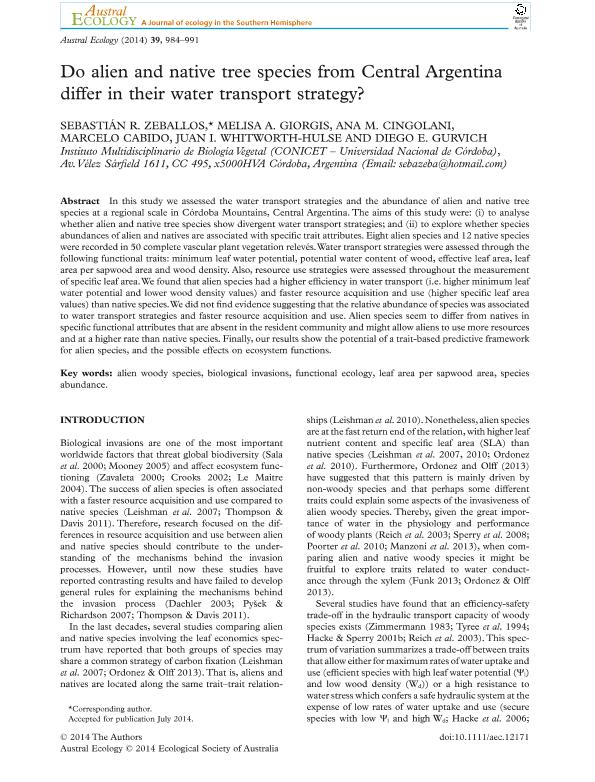Mostrar el registro sencillo del ítem
dc.contributor.author
Zeballos, Sebastián Rodolfo

dc.contributor.author
Giorgis, Melisa Adriana

dc.contributor.author
Cingolani, Ana María

dc.contributor.author
Cabido, Marcelo Ruben

dc.contributor.author
Whitworth Hulse, Juan Ignacio

dc.contributor.author
Gurvich, Diego Ezequiel

dc.date.available
2017-10-25T12:44:23Z
dc.date.issued
2014-08
dc.identifier.citation
Zeballos, Sebastián Rodolfo; Giorgis, Melisa Adriana; Cingolani, Ana María; Cabido, Marcelo Ruben; Whitworth Hulse, Juan Ignacio; et al.; Do alien and native tree species from Central Argentina differ in their water transport strategy?; Wiley; Austral Ecology; 39; 8; 8-2014; 984-991
dc.identifier.issn
1442-9985
dc.identifier.uri
http://hdl.handle.net/11336/27046
dc.description.abstract
In this study we assessed the water transport strategies and the abundance of alien and native tree species at a regional scale in Córdoba Mountains, Central Argentina. The aims of this study were: 1) to analyze whether alien and native tree species show divergent water transport strategies; and 2) to explore whether species abundances of alien and natives are associated with specific trait attributes. Eight alien species and 12 native species were recorded in 50 complete vascular plant vegetation relevés. Water transport strategies were assessed through the following functional traits: minimum leaf water potential, potential water content of wood, effective leaf area, leaf area per sapwood area, and wood density. Also, resource use strategies were assessed throughout the measurement of specific leaf area. We found that alien species had a higher efficiency in water transport (i.e. higher minimum leaf water potential and lower wood density values) and faster resource acquisition and use (higher specific leaf area values) than native species. We did not find evidence suggesting that the relative abundance of species was associated to water transport strategies and faster resource acquisition and use. Alien species seem to differ from natives in specific functional attributes that are absent in the resident community and might allow aliens to use more resources and at a higher rate than native species. Finally, our results show the potential of a trait based predictive framework for alien species, and the possible effects on ecosystem functions.
dc.format
application/pdf
dc.language.iso
eng
dc.publisher
Wiley

dc.rights
info:eu-repo/semantics/openAccess
dc.rights.uri
https://creativecommons.org/licenses/by-nc-sa/2.5/ar/
dc.subject
Alien Woody Species
dc.subject
Biological Invasions
dc.subject
Functional Ecology
dc.subject
Leaf Area Per Sapwood Area
dc.subject
Species Abundance
dc.subject.classification
Bioquímica y Biología Molecular

dc.subject.classification
Ciencias Biológicas

dc.subject.classification
CIENCIAS NATURALES Y EXACTAS

dc.title
Do alien and native tree species from Central Argentina differ in their water transport strategy?
dc.type
info:eu-repo/semantics/article
dc.type
info:ar-repo/semantics/artículo
dc.type
info:eu-repo/semantics/publishedVersion
dc.date.updated
2017-10-10T18:33:57Z
dc.journal.volume
39
dc.journal.number
8
dc.journal.pagination
984-991
dc.journal.pais
Estados Unidos

dc.journal.ciudad
Hoboken
dc.description.fil
Fil: Zeballos, Sebastián Rodolfo. Consejo Nacional de Investigaciones Científicas y Técnicas. Centro Científico Tecnológico Conicet - Córdoba. Instituto Multidisciplinario de Biología Vegetal. Universidad Nacional de Córdoba. Facultad de Ciencias Exactas Físicas y Naturales. Instituto Multidisciplinario de Biología Vegetal; Argentina
dc.description.fil
Fil: Giorgis, Melisa Adriana. Consejo Nacional de Investigaciones Científicas y Técnicas. Centro Científico Tecnológico Conicet - Córdoba. Instituto Multidisciplinario de Biología Vegetal. Universidad Nacional de Córdoba. Facultad de Ciencias Exactas Físicas y Naturales. Instituto Multidisciplinario de Biología Vegetal; Argentina
dc.description.fil
Fil: Cingolani, Ana María. Consejo Nacional de Investigaciones Científicas y Técnicas. Centro Científico Tecnológico Conicet - Córdoba. Instituto Multidisciplinario de Biología Vegetal. Universidad Nacional de Córdoba. Facultad de Ciencias Exactas Físicas y Naturales. Instituto Multidisciplinario de Biología Vegetal; Argentina
dc.description.fil
Fil: Cabido, Marcelo Ruben. Consejo Nacional de Investigaciones Científicas y Técnicas. Centro Científico Tecnológico Conicet - Córdoba. Instituto Multidisciplinario de Biología Vegetal. Universidad Nacional de Córdoba. Facultad de Ciencias Exactas Físicas y Naturales. Instituto Multidisciplinario de Biología Vegetal; Argentina
dc.description.fil
Fil: Whitworth Hulse, Juan Ignacio. Consejo Nacional de Investigaciones Científicas y Técnicas. Centro Científico Tecnológico Conicet - Córdoba. Instituto Multidisciplinario de Biología Vegetal. Universidad Nacional de Córdoba. Facultad de Ciencias Exactas Físicas y Naturales. Instituto Multidisciplinario de Biología Vegetal; Argentina
dc.description.fil
Fil: Gurvich, Diego Ezequiel. Consejo Nacional de Investigaciones Científicas y Técnicas. Centro Científico Tecnológico Conicet - Córdoba. Instituto Multidisciplinario de Biología Vegetal. Universidad Nacional de Córdoba. Facultad de Ciencias Exactas Físicas y Naturales. Instituto Multidisciplinario de Biología Vegetal; Argentina
dc.journal.title
Austral Ecology

dc.relation.alternativeid
info:eu-repo/semantics/altIdentifier/url/http://onlinelibrary.wiley.com/doi/10.1111/aec.12171/abstract
dc.relation.alternativeid
info:eu-repo/semantics/altIdentifier/doi/http://dx.doi.org/10.1111/aec.12171
Archivos asociados
